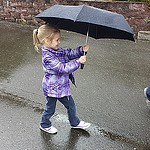How to preserve different sizes when cutting pattern?
-
13 years ago LINK
lianakrissoff @lianakrissoff
I’ve been wondering for years what the best way to do this is. Does anybody have any easy methods for preserving the other sizes—especially the larger ones—when cutting out a paper pattern? In most cases I can just eyeball it, adding a little here and there, or taping the leftover (if I’ve saved it, and if it’s easy enough to determine which scrap of paper goes with which piece), when I make a pattern in a larger size (say, as my daughter grows), but I’d love to have a more foolproof method. Sleeves and such are a little trickier, of course. What do y’all do? Is there a trick to this?
13 years ago LINKWillanna @Willanna
With more expensive patterns (like Oliver and S), I trace the size I need onto another piece of paper instead of cutting the actual pattern. I am a physician, so I use the exam paper that we use to cover tables in our office (you know, the stuff you sit on when you see the doctor!) to trace the pattern onto. It is thin enough to make tracing easy, but is sturdier than tissue paper. You could probably order it online, or ask your doctors’ office. It does add an extra step, but it’s already paid off for me since I’ve used a few patterns in more than one size already (and my daughter’s still growing!).
I’ve also heard some people use freezer paper–that would be a pricier option, but has the advantage that you could iron the pattern pieces to your fabric before cutting.
For cheaper patterns, I cut a size larger than I think I’ll need and just fold it back.
13 years ago LINK Tamara
@justsewit
Tamara
@justsewit
Tracing. Definitely! I learned the hard way with a couple of Oliver and s patterns that it would be far better to trace the size rather than to cut the actual pattern piece out. The patterns I have cut (due to habit of cutting patterns) are now becoming deteriorated and it makes it harder to put them in a somewhat ripped packet.
By tracing, you can use that pattern instead and you know that it will fit. Children when they are smaller generally don’t grow six sizes in a year so that chances of much use from the traced pattern is great.
They are also fabulous if you want to enlarge the largest size which is what I have to do now with my 9 nearly 10 year old daughter’s clothes. She is taller and larger in some places than the body measurements require for a size 12 on these patterns but it isn’t a big deal as enlarging them to fit her using traced patterns will preserve the pattern itself.
So tracing does have its benefits in two ways. I use cheap non iron on interfacing to do mine as I can get it on a 10 m roll and this is my pattern tracing method. You can use tracing paper or even grease proof paper but it is best to get sheets that are quite wide to avoid having to stick them together.
I have always cut the largest size on the patterns so that if I need it I can use it instead of having to buy another copy. But tracing is ten times better than cutting the actual pattern. That way the pattern itself lasts so much longer.
Hope this helps. Good luck
13 years ago LINKlianakrissoff @lianakrissoff
Willanna and justsewit: Tracing is an excellent suggestion. I’ll definitely find some suitable paper or interfacing and do that the next time. I guess I’d just never considered doing that for some reason—probably because I’m lazy and thought of it as an extra step, though of course it saves more time than it takes the next time you use the pattern. Yes. Thank you so much!
13 years ago LINK meleliza
@meleliza
meleliza
@meleliza
I buy tracing paper by the roll at the art supply store. I always trace the children’s patterns because I’ll use various sizes. Sometimes you my even make more than one from each size. Patterns for me I usually only use one size. Though even expensive patterns for me I will trace. Because they’re expensive I worry more about destroying the actual pattern with a mistake. Even in cheap patterns for me I may trace if I need to make major adjustments. That way I can always start over again if the re drafting doesn’t go as planned.
I’m getting a lot more out of the kids patterns these days. Baby girl doesn’t seem to grow as quickly as the boys. My oldest son is enourmous and a super fast growers and he set the bar of my perspective. Now the other two seem tiny, though they’re not.
13 years ago LINKrastis @rastis
yes, trace, trace, trace! i actually never cut any patterns, children’s or my own ladies patterns… i like to be able to make many sizes to get the best value! (patterns are more expensive here in australia!)
13 years ago LINKjanimal @janimal
I trace all patterns. I ordered a couple rolls of pattern tracing paper online a few years ago and use it all the time. I even trace bag patterns! There is only one size to the bag, but I really like having the original pattern intact. I can give it away later – or if my traced version gets torn or otherwise tarnished, I can just trace another that way. I keep my traced pieces in extra large envelopes with the pattern info on the outside, and the original patterns can then fold up nicely back in the original envelope.
13 years ago LINKthe6greers @the6greers
I trace as well. I have 2 girls that are just 13 months apart and they are, at the moment, just 1 size apart. I just use old computer paper and tape it together. It is thicker and takes the abuse of pinning and re-pinning as I like to make tons of the same pattern in multiply different fabrics:)
13 years ago LINKtami @tami
I trace all my patterns too. Joann’s sells something called Easy Pattern. It’s in the interfacing section. Lightweight but not tissue, folds up great!
13 years ago LINK Jess M.
@mommy2maria
Jess M.
@mommy2maria
I trace all my patterns as well. I use Freezer Paper. I get the HUGE roll, and use one of those paper roll stands from IKEA that you find in the kids section to hold it in my craft room. Then, I label each piece with it’s pattern name and size I traced and any modifications I made (example: 2+2 Blouse Sleeve Size 2T w/ 3T length etc) and when I’m finished I put them in a ziploc bag and file them away in a file drawer.
I maybe buy 2-3 rolls a year, and that’s even after using the paper to actually put up meats in the freezer lol.
13 years ago LINK sayiamyou
@maraya
sayiamyou
@maraya
I trace everything, and this is my favorite style of tracing paper: http://www.amazon.com/gp/product/B000PNEWVU/ref=pd_lpo_k2_dp_sr_1?pf_rd_p=486539851&pf_rd_s=lpo-top-stripe-1&pf_rd_t=201&pf_rd_i=B004AMCJ08&pf_rd_m=ATVPDKIKX0DER&pf_rd_r=09QCCHSGK12X1JK8JHDS
13 years ago LINK Nicole
@motherof5
Nicole
@motherof5
Bumped
13 years ago LINKwendy @wendyls
I trace too. I use a Burda tracing paper because it’s readily available to me. It’s heavier than regular pattern tissue and holds up well. The really nice thing about it is that it has a bit of cling when ironed onto most fabrics, so I don’t tend to pin. I just press it onto my fabric and cut around it. It’s somewhat translucent as well, which makes it great for pattern matching.
You must be logged in to reply to this topic.
copyright
Unless otherwise credited, all work on this blog is © Liesl + Co., Inc, 2008-2026. You are welcome to link to this blog, but please ask permission before using any text or images.